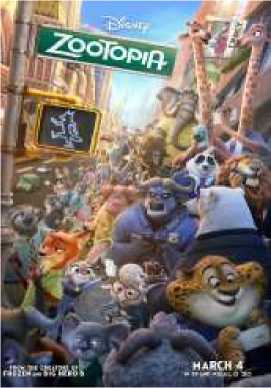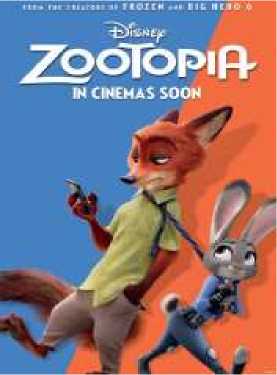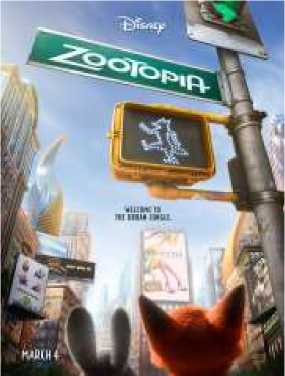Verbal and Non-Verbal Signs of “Zootopia” Movie Poster
on
ISSN: 2302-920X
Jurnal Humanis, Fakultas Ilmu Budaya Unud
Vol 18.2 Pebruari 2017: 260-268
Verbal and Non-Verbal Signs of “Zootopia” Movie Poster
Ni Putu Narista Devi1*, Ni Luh Sutjiati Beratha2, I Made Netra3 [123]English Department, Faculty of Arts – Udayana University 1[email: putu.naristadevi@gmail.com] 2[email: sutjiati95@gmail.com] 3[email: dektih@yahoo.com]
*Corresponding Author
Abstrak
Skripsi ini berjudul “Tanda Verbal dan Tanda Non-Verbal pada Poster Film Zootopia”. Penelitian ini difokuskan pada analisis tanda verbal dan non-verbal pada poster film Zootopia, dan arti dari tanda-tanda tersebut. Penelitian ini bertujuan untuk mengidentifikasi jenis-jenis tanda verbal dan non-verbal yang ditemukan pada poster film Zootopia, serta menjelaskan arti dari tanda verbal dan non-verbal tersebut.
Data penelitian ini bersumber dari dua situs web yang ada di Internet. Metoda dokumentasi digunakan untuk mengumpulkan data pada penelitian ini. Kemudian, data yang telah dikumpulkan dianalisa menggunakan metoda deskriptif kualitatif. Teori-teori yang diterapkan dalam peneltian ini adalah teori Semiotics dari Saussure (1983), teori Verbal and Non-Verbal Signs dari Dyer (1993), didukung oleh teori Color terms dari Wierzbicka (1996) dan Color Meaning dari Chapman (2010).
Hasil penelitian menunjukkan bahwa poster-poster dari film Zootopia mempunyai tanda verbal dan non-verbal. Tanda verbal yang terdapat dalam poster antara lalin “Disney”, “Zootopia”, “FROM THE CREATORS OF FROZEN AND BIG HERO 6”, “March 4”, “IN 3D AND REALD 3D”, “DNKY”, “IN CINEMAS SOON”, “WELCOME TO THE URBAN JUNGLE”, “JUST ZOO IT”, “lululemmings”, “PREYDA”, dan “BEARBERRY”. Tanda nonverbal dalam poster itu adalah gambar yang meliputi bentuk, rupa fisik, gerakan tubuh, aktivitas, latar belakang, dan warna. Tanda – tanda tersebut memberikan banyak informasi tentang film Zootopia seperti perusahaan yang memproduksinya, judul film, tanggal ditayangkannya film, kualitas film, karakter-karakter dalam film, dan juga pengaturan tempat dari film tersebut.
Kata kunci: tanda verbal, tanda non-verbal, poster film
Communication is one of the major human concerns in order to make their lives run well. It also means that communication is really important for human social life. There are various ways of doing the communication, whether it is through verbal or non-verbal communication. Moreover, there are various media that can be used in doing communication. One of the communication media which is often used by people is the media of advertising. The advertising media is a medium used by people or company to introduce and promote their products or services to public. This media is a mass communication that can draw the interest of people to buy and use the products and services.
According to Dyer (1982:17), the term ‘advertising’ means drawing attention to something, or notifying, or informing somebody of something. Therefore, when the advertisers want to draw someone’s attention to certain products and persuade someone to buy and use the products or services, the advertising media becomes the most appropriate media to be used. There are various kinds of advertising media. One of them is movie poster.
Movie poster becomes an important part for informing and persuading people to watch the movies. It certainly becomes the appropriate media to attract the interest and curiosity of the people. Moreover, it can also give the important information about the movie. The movie poster, furthermore, has a lot of signs namely verbal and non-verbal signs as well as the meaning and messages conveyed by those signs. In some cases, some people may understand the messages appropriately. However, the others may not understand the messages or misunderstand about those signs.
Each movie has its own poster. One example of movie posters is “Zootopia” movie poster. “Zootopia” movie poster is the poster of “Zootopia” movie; the movie that tells about a city of the modern mammal metropolis called Zootopia (Disney).
Therefore, in this study, it is interesting to analyze the verbal and non-verbal signs found in “Zootopia” movie posters and the meanings of those signs. The topic is 261
interesting because “Zootopia” movie has interesting story as well as the posters of “Zootopia” movie have many signs including verbal and non-verbal signs, and the meanings of those signs that require to be analyzed. By analyzing the movie posters, it is expected that it can help people understand the meanings or messages of the signs in the movie posters appropriately, and avoid the misunderstanding or ambiguous meaning of those signs in the movie posters.
Based on the explanation above, there are two problems arising in this study that can be formulated as follows:
-
1. What kinds of verbal and non-verbal signs are found in “Zootopia” movie posters? 2. What are the meanings of verbal and non-verbal signs in “Zootopia” movie posters?
Based on the problems above, the aims of this study are as follows:
-
1. To identify the kinds of verbal and non-verbal signs found in “Zootopia” movie posters.
-
2. To explain the meaning of verbal and non-verbal signs in “Zootopia” movie posters.
In this study, the data were taken from two websites namely http://www.moviesnowshowing.com/movie/3558/zootopia.html and
http://www.impawards.com/2016/zootopia.html. There are three movie posters of “Zootopia” movie discussed in this study. The data in this study were collected using the documentation method as well as recording and note-taking techniques. Then, the collected data were analyzed using the qualitative and descriptive method. The main theories used in this study are the theories of signifier and signified proposed by Saussure (1983), and the theory about verbal and non-verbal signs proposed by Dyer (1993), and supported by theory of color terms by Wierzbicka (1996), and color meaning by Chapman (2010).
The discussion was focused on two important things. The first point is identifying the verbal and non-verbal signs found in “Zootopia” movie posters; and the second point is explaining the meanings of verbal and non-verbal signs in those movie posters.

This poster was taken from
http://www.moviesnowshowing.com/movie/3558/zootopia.html.
There are six verbal signs found in the first poster. The first verbal sign is “Disney”, which indicates that it is the company that produces Zootopia movie. “Disney” is the name of a company that produces and provides many great entertainments. The second verbal sign is “ZOOTOPIA, which is the title of this movie. The third verbal sign is “FROM THE CREATORS OF FROZEN AND BIG HERO 6”, which signifies that the creator of Zootopia movie is the same as the creators of Frozen and Big Hero 6 movies. The fourth verbal sign is “MARCH 4”, which provides the information to the viewers about the release date of the movie. The fifth verbal sign is “IN 3D AND REALD 3D” that signifies that this movie is in a good quality (3D and REALD 3D). The sixth verbal sign is “DNKY”, which may signify that it is a brand name of the bag or dress worn by the model.
The first poster is shaped like a city of modern mammal where all animals live. That city looks so crowded with many tall buildings, vehicles on the road, pedestrians (modern mammals) on the sidewalk. Those non-verbal signs give the viewers a clear idea about what Zootopia is, and how Zootopia looks like. Besides, in that poster, there are also mammals that look like human; they wear clothes and also act like what real humans do. Those non-verbal signs tell the viewers that in the Zootopia city, there are many mammals as the citizens. It can give a clear information about how the citizen in the Zootopia city look like.

This poster was taken from
http://www.moviesnowshowing.com/movie/3558/zootopia.html.
There are four verbal signs found in this poster. The first verbal sign is “FROM THE CREATORS OF FROZEN AND BIG HERO 6”. This signifier signifies that the creator of Zootopia movie is the same as the creators of Frozen and Big Hero 6 movies. The second verbal sign is “Disney”, which signifies that Zootopia Movie is produced by a company named “Disney”. The third verbal sign is “ZOOTOPIA”, which represents the title of the movie. The fourth verbal sign is “IN CINEMAS SOON”, which signifies that Zootopia movie will be released in cinemas sooner.
In the second poster, there are only a rabbit and a fox in that poster. It may signify that the rabbit and fox are the main characters in the movie. The rabbit in that poster wears a police uniform, which indicates that she is a police officer, while the fox only wears a shirt that indicates he is only the citizen. The rabbit in that poster looks so enthusiastic and happy. While the fox only focuses on his phone. These signifiers may draw the curiousity of the viewers to watch this movie.

This poster was taken from
http://www.impawards.com/2016/ zootopia.html
There are eight verbal signs found in this poster. The first verbal sign is “Disney”, which signifies the name of a company that produced Zootopia movie. The second verbal sign is “ZOOTOPIA”, which is the title of the movie. The third verbal sign is “WELCOME TO THE URBAN JUNGLE” that can express the whole movie, so when the viewers see it, they can guess what this movie tells about. The fourth verbal sign is “MARCH 4”, which indicates the release date of the movie so that the viewers can watch it on time.
Then, the fifth verbal sign is “JUST ZOO IT”, which represents that it is one of the advertisements in the Zootopia city. It looks like that it is a movie poster in the city. The sixth verbal sign is “lululemmings”. It may indicate that “lululemmings” is the name of
a place for doing yoga owned by lemmings. The seventh verbal sign is “PREYDA”, which may signify that it is a brand name of the bag, heels, or dress worn by the model. The last verbal sign is “BEARBERRY”. It may signify that it is a brand name of the suit owned by bear, or the name of a place for selling suit owned by bear, or the place that only sell suits or clothes for bears.
The third poster is focused on a city named Zootopia. This signifier of the third poster may signify that something happened in that city. Besides, it can be seen that there are two mammals, a rabbit and a fox, who are looking up. However, the viewers only can see the heads of rabbit and fox since the focus of this poster is the city itself. When the viewers see this poster, they may be confused and want to know what happened in that city, and why the focus of this poster is the city itself, even the main characters of this movie also look at the city.
Based on the analysis and discussion above, it can be concluded that those Zootopia movie posters have verbal and non-verbal signs. The verbal signs are “Disney”, “Zootopia”, “FROM THE CREATORS OF FROZEN AND BIG HERO”, “March 4”, “IN 3D AND REALD 3D”, “DNKY”, “IN CINEMAS SOON”, “WELCOME TO THE URBAN JUNGLE”, “JUST ZOO IT”, “lululemmings”, “PREYDA”, and “BEARBERRY”. Then, the non-verbal signs consist of shape, appearance, manner, activity, background, and color.
Furthermore, those verbal and non-verbal signs have their meanings and messages. The verbal sign “Disney” gives the viewers information that Zootopia movie is produced by a company namely Disney. “ZOOTOPIA” gives the viewers information that the title of this movie is Zootopia. “FROM THE CREATORS OF FROZEN AND BIG HERO 6” signifies that the creator of Zootopia movie is similar to the creators of Frozen and Big Hero 6 movies. “March 4” provides the information to the viewers that Zootopia movie will be released on March 4. “IN 3D AND REALD 3D” indicates that this movie is released in 3D and RealD 3D quality. “IN CINEMAS SOON” signifies that the Zootopia movie will be released in cinemas sooner. “WELCOME TO THE 266
URBAN JUNGLE” expresses the whole movie. “DNKY”, “JUST ZOO IT”, “lululemmings”, “PREYDA”, and “BEARBERRY” represent the billboards or advertisements in the Zootopia city.
Then, the non-verbal signs such as shape, appearance, manner, activity, background, and color also have their own meanings. Those signs provide the information to the viewers about the characters of the movie, expression, emotion, pose, and clothes of those characters and what they do, as well as all things in the city such as buildings, cars, and citizen (mammals).
Businesscom. The Business Communication: What is verbal communication and nonverbal communication?: http://thebusinesscommunication.com/what-is-verbal-
communication-and-non-verbal-communication/. (accessed on December 3, 2016).
Chandler, Daniel. 2001. Semiotics for Beginners: http://visual-
memory.co.uk/daniel/Documents/S4B/ (accessed on March 13, 2016).
Chapman, Cameron. 2010. Color Theory for Designers, Part 1: The Meaning of Color: https://www.smashingmagazine.com/2010/01/color-theory-for-designers-part-1-the-meaning-of-color/ (accessed on December 3, 2016)
Dyer, Gillian. 1986. Advertising as Communication. London: Methuen & Co. Ltd.
Dyer, Gillian. 1993. Advertising as Communication. London: Routledge.
Eberhardinger, Mary J. 2012. A Semiotic Analysis of Iconicity in Japanese Manner
Posters: https://libres.uncg.edu/ir/uncg/f/M_Eberhardinger_ Semiotic_2012.pdf. (accessed on February 28, 2016).
Hornby, A.S. 2008. Oxford Learner’s Pocket Dictionary: Fourth Edition. Oxford: Oxford University Press.
Kariko, Abdul Aziz Turhan. 2013. Analysis On Internet Memes Using Semiotics: http://english.binus.ac.id/2013/06/24/analysis-on-internet-memes-using-semiotics/ (accessed on February 28, 2016).
Kurniawan, Ronaldus Bagus. 2009. “Verbal Analysis of Advertisement at American Photo Magazine”(undergraduate thesis). Denpasar: Udayana University.
Puranik, Amey. Meaning, Definition, Objective and Functions of Advertising: http://www.publishyourarticles.net/knowledge-hub/business-studies/advertising/1028/ (accessed on March 13, 2016).
Saussure, Ferdinand de. 1915. Course in General Linguistics. Geneva: McGraw-Hill Book Company.
Saussure, Ferdinand de. 1983. Theory of Signified and Signifier. Geneva: McGraw-Hill Book Company.
Sudiantara, I Komang Edy. 2013. “The Analysis Verbal and Non-Verbal Signs of Printed Public Service Advertisements” (undergraduate thesis). Denpasar: Udayana University.
Suksema, Dewa Gede Eling Beratha. 2015. “Analysis of Semiotic Signs of the Poster “House at the end of the Street” Movie” (undergraduate thesis). Denpasar: Udayana University.
Wierzbicka, Anna. 1996. Semantics: Primes and Universals. Oxford University Press
Zootopia, Disney. http://movies.disney.id/zootopia (accessed on April 17, 2016).
http://disney.wikia.com/wiki/Zootopia (accessed on December 3, 2016).
https://en.wikipedia.org/wiki/The_Walt_Disney_Company (accessed on December 3, 2016).
https://www.amctheatres.com/reald-3d (accessed on December 4, 2016).
http://www.impawards.com/2016/zootopia.html (accessed on December 2, 2016).
http://www.moviesnowshowing.com/movie/3558/zootopia.html (accessed on April 17, 2016)
268
Discussion and feedback